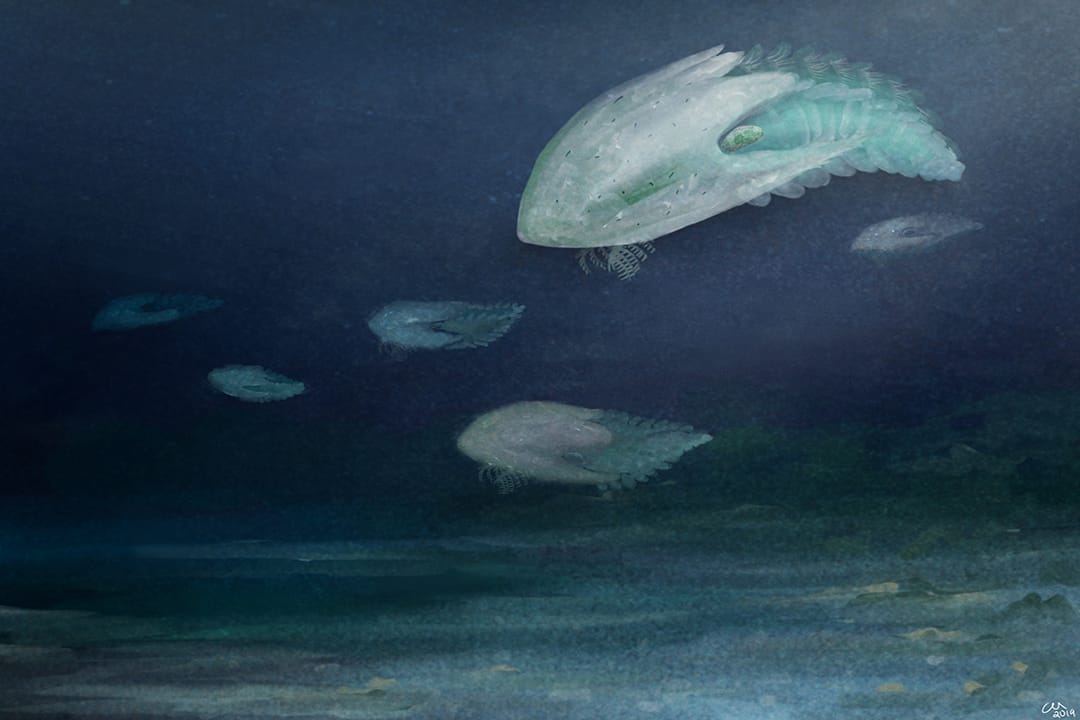Fossils of a new predatory species named Cambroraster have been uncovered in British Columbia by U of T PhD student Joe Moysiuk, together with a team of palaeontologists from the Royal Ontario Museum (ROM).
The animal dates back 500 million years, and is described by Moysiuk to have “a mouth apparatus that looks like a pineapple slice with teeth inside” and “rake-like claws.” This incredible discovery provides insight into the evolution of its modern relatives — including insects, crabs, and spiders.
The big discovery
Moysiuk began exploring the Marble Canyon, a site in the Burgess Shale in the Kootenay and Yoho National Parks, in the summer of 2014. The original Burgess Shale has been known for approximately 100 years but some of the newer sites, including Marble Canyon, have only recently been discovered.
Here, Moysiuk and his colleagues, led by the Richard M. Ivey Curator of Invertebrate Palaeontology Jean-Bernard Caron, found a fossil that no one recognized. “We didn’t know what to make of this thing at first; we had never seen anything like it before,” said Moysiuk.
The team nicknamed the species the “spaceship” on the spot, due to the appearance of its radial teeth in the rock, but the species was later given the scientific name Cambroraster falcatus. “As the excavations went on, it became more and more clear what we were looking at,” recalled Moysiuk.
The species was found to be a 500-million-year-old marine predator with rake-like claws and radial teeth that grew up to a foot in length. Belonging to a group called the Radiodonta, it is related to the apex predator Anomalocaris — a metre-long marine species with giant grasping claws capable of preying on fast-moving organisms. The discovery of Cambroraster shows that Radiodonta may have been far more diverse than previously thought.
Moysiuk describes two aspects that make the Burgess Shale site remarkable: its age, and the extraordinary preservation of its fossils. The site that held the Cambroraster’s fossils dated back to the Cambrian period, which is more than seven times older than the era of the Tyrannosaurus rex.
The Cambrian period was “an extremely rapid period of evolution,” noted Moysiuk. It provides paleontologists with “representatives of virtually all of the major modern groups of animals coming into the fossil record all at once.”
The Burgess Shale site also provides remarkable insight into the Cambrian ecosystem because fossils found there often contain preserved soft tissue. Because of this, researchers learn a great deal about the organisms of the Burgess Shale and get a unique window into life during the Cambrian period.
“When we think of fossils, we tend to think of things like dinosaur bones, shells, and teeth — hard parts of animals that are easily preserved,” said Moysiuk. “In the Burgess Shale we get, not only those parts, but also things like eyes, nervous systems, and even digestive tracts containing the last meal of the animal.”
The challenges of identifying a species from rock
Unlike dinosaur bones in fossils where the rock is very soft, explained Moysiuk, “these fossils are extremely hard, flat, and almost two-dimensional sheets of carbon.” The process therefore involves breaking out big blocks of rock and splitting it as finely as possible to uncover a fossil. “The fossils actually sort of form a layer of weakness in the rock, allowing the rock to split where the fossil is,” he continued.
However, the almost two-dimensional form of these fossils can make it difficult to recreate the animal in three dimensions. Researchers will peel away layers of the fossil “like the layers of an onion” in order to see what’s underneath, and to help get fossils from different angles.
“A fossil with its front sticking up in the mud looks different from one preserved at the top-up,” noted Moysiuk, “and so [by] putting this information together, we are able to reconstruct things in three dimensions — but this can be quite challenging.”
How Cambroraster can tell us about biodiversity today
Prior to the Cambrian period, the ocean floor was very low in oxygen, and any nutrients in the sediment were trapped and unable to surface. “When we get into the Cambrian, we start seeing organisms [like Cambroraster] digging deeper and deeper progressively into the sediment,” said Moysiuk, “and exhibiting more complex burrowing patterns to draw oxygen down into the sediment.”
The Cambroraster’s digging would allow decomposition of the organic matter, which recycles it back into the marine ecosystem. The species was also a specialist predator, which would have preyed on organisms buried in the sediment.
“Cambroraster is playing a role that is analogous to what a lot of modern bottom-feeding organisms play today,” noted Moysiuk. “So this is a mode of life that has persisted ever since.”
What’s next for Moysiuk and his colleagues at the ROM?
The discovery of new sites, including those in the Marble Canyon in the Canadian Rockies, has led to researchers uncovering huge collections of fossils, including several other new species other than Cambroraster. Moysiuk is interested in studying the new species of radiodonts found at these sites, as well as exploring how these species may have contributed to the evolution of modern marine biodiversity.
“There is a lot more work to be done in terms of understanding these ecosystems,” said Moysiuk, “and [the] organisms that were living in them.”


